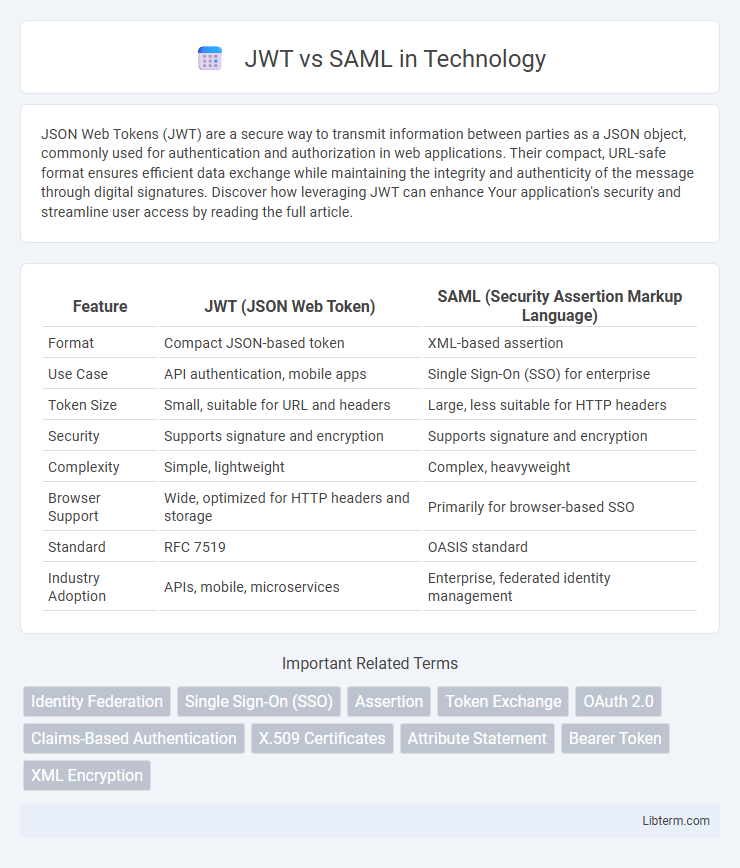JSON Web Tokens (JWT) are a secure way to transmit information between parties as a JSON object, commonly used for authentication and authorization in web applications. Their compact, URL-safe format ensures efficient data exchange while maintaining the integrity and authenticity of the message through digital signatures. Discover how leveraging JWT can enhance Your application's security and streamline user access by reading the full article.
Table of Comparison
| Feature | JWT (JSON Web Token) | SAML (Security Assertion Markup Language) |
|---|---|---|
| Format | Compact JSON-based token | XML-based assertion |
| Use Case | API authentication, mobile apps | Single Sign-On (SSO) for enterprise |
| Token Size | Small, suitable for URL and headers | Large, less suitable for HTTP headers |
| Security | Supports signature and encryption | Supports signature and encryption |
| Complexity | Simple, lightweight | Complex, heavyweight |
| Browser Support | Wide, optimized for HTTP headers and storage | Primarily for browser-based SSO |
| Standard | RFC 7519 | OASIS standard |
| Industry Adoption | APIs, mobile, microservices | Enterprise, federated identity management |
Introduction to JWT and SAML
JWT (JSON Web Token) is a compact, URL-safe token format used for securely transmitting information between parties as a JSON object, widely utilized in modern web authentication and authorization. SAML (Security Assertion Markup Language) is an XML-based framework for exchanging authentication and authorization data, predominantly used in enterprise single sign-on (SSO) scenarios. Both serve as standards for identity federation, with JWT optimized for lightweight, stateless applications and SAML better suited for complex, enterprise-level integrations.
What is JWT?
JWT (JSON Web Token) is a compact, URL-safe token format used for securely transmitting information between parties as a JSON object. It consists of three parts: a header, payload, and signature, enabling verification and trust without server-side storage. JWT is widely used in modern authentication and authorization scenarios, particularly for single sign-on (SSO) and API security.
What is SAML?
SAML (Security Assertion Markup Language) is an XML-based open standard for exchanging authentication and authorization data between parties, particularly between an identity provider and a service provider. It enables single sign-on (SSO) by allowing users to authenticate once and gain access to multiple applications, commonly used in enterprise environments. SAML assertions contain user identity information and access rights, facilitating secure and interoperable user authentication across different security domains.
Key Differences Between JWT and SAML
JWT (JSON Web Token) uses a compact, URL-safe JSON format ideal for mobile and web applications, while SAML (Security Assertion Markup Language) relies on XML-based assertions primarily suited for enterprise-level Single Sign-On (SSO). JWT tokens are stateless and smaller in size, enabling faster parsing and transmission, whereas SAML assertions are more verbose, often requiring complex XML parsing and larger payloads. Security-wise, JWT typically uses signing and encryption methods like HMAC or RSA, whereas SAML supports extensive security features including XML signatures and encryption, making it a robust choice for federated identity systems.
Use Cases for JWT
JWT is widely used in mobile and single-page applications for secure token-based authentication and authorization, enabling stateless, scalable user session management. It shines in microservices architecture by facilitating token exchange between services without requiring centralized session storage. Ideal for modern APIs, JWT ensures efficient, compact, and URL-safe token transmission, supporting seamless user identity verification and access control across distributed systems.
Use Cases for SAML
SAML is primarily used for Single Sign-On (SSO) in enterprise environments, enabling secure authentication across various web-based applications within large organizations. It excels in scenarios requiring federation between identity providers and service providers, often in government, healthcare, and financial sectors. SAML's XML-based protocol supports complex authorization assertions, making it ideal for environments demanding robust security and compliance.
Security Comparison: JWT vs SAML
JWT (JSON Web Token) and SAML (Security Assertion Markup Language) both provide secure authentication mechanisms, but differ significantly in their security features. SAML uses XML-based assertions and relies on extensive encryption and digital signatures, offering robust protection against token tampering and replay attacks, making it ideal for enterprise-level single sign-on (SSO) scenarios. JWT, while lighter and more suited for web and mobile applications, uses JSON objects with signature and optional encryption, but its security heavily depends on proper implementation of token expiration and signature verification to prevent vulnerabilities.
Performance and Scalability
JWT offers superior performance and scalability compared to SAML due to its lightweight JSON format, which reduces payload size and parsing time. SAML, based on XML, involves more complex processing and larger message sizes, leading to increased latency and heavier server loads. Systems requiring high throughput and efficient resource utilization typically prefer JWT for authentication and authorization tasks.
Implementation Challenges
Implementing JWT involves managing token expiration and secure storage to prevent unauthorized access, requiring careful handling of secret keys and signing algorithms. SAML implementation challenges include complex XML parsing, intricate metadata exchange, and ensuring compatibility across different identity providers and service providers. Both standards demand rigorous security auditing to mitigate risks such as token tampering and replay attacks.
Choosing the Right Solution
Choosing between JWT and SAML depends on the application's security requirements and use case scenarios. JWT offers lightweight, stateless authentication ideal for mobile and single-page applications, providing faster transmission and easier scalability. SAML excels in enterprise environments requiring robust federation and single sign-on (SSO) across multiple domains with enhanced XML-based security protocols.
JWT Infographic

 libterm.com
libterm.com